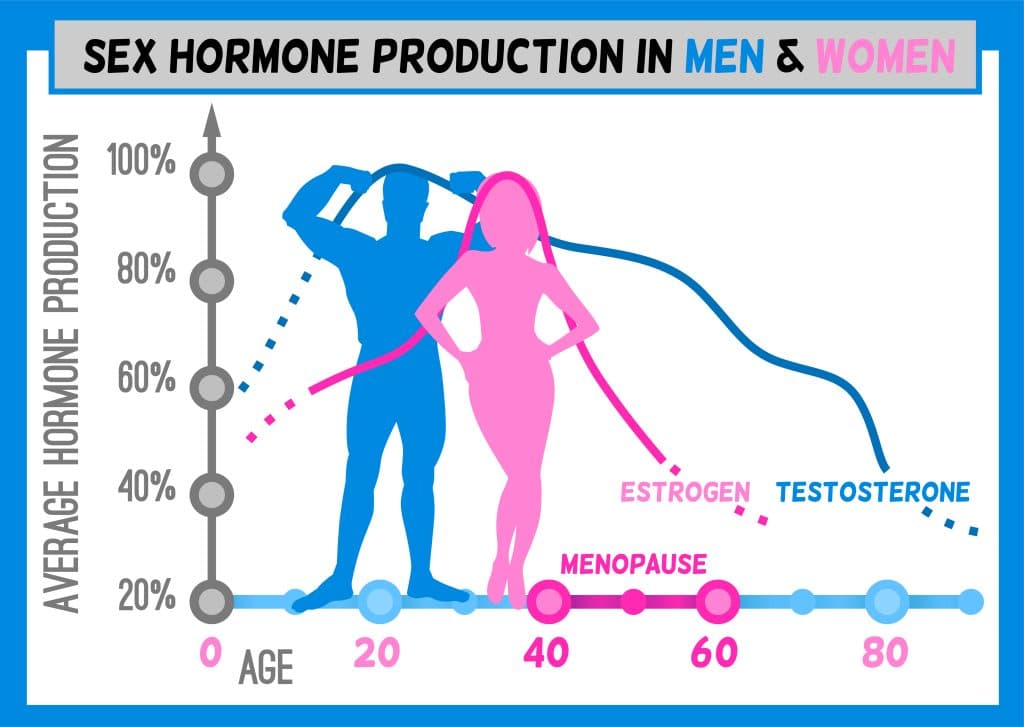A new study published in Menopause, the journal of the North American Menopause Society (NAMS) in August 2022, shows that a high percentage of women going through either peri-menopause or post-menopause are using cannabis to treat their symptoms. The legalization of cannabis in Canada in 2018, and the growing number of U.S. states legalizing medical cannabis has given this population of women access to the plant.
The dramatic shift in hormones during menopausal years can cause an array of symptoms that include anxiety, irritability, brain fog, fatigue, depression, weight gain, joint stiffness, insomnia and hot flashes. Though some women opt for hormone replacement therapy, this treatment has fallen out of favor in recent years, prompting many women to seek alternative non-hormonal treatments.
What is Menopause?
The symptoms most typically associated with menopause are night sweats, hot flashes, mood swings and brain fog. However, these symptoms are in fact related to the first stage of menopause, known as peri-menopause. Menopause has three stages, and it’s important to differentiate between them as hormones are fluctuating at different levels during each stage.
Understanding the hormonal differences can help women manage the symptoms of each stage. No two women will experience menopause in the same way. Menopause occurs at different ages for individual women, but generally happens in the mid to late 40s to early 50s. The average age to start experiencing peri-menopause symptoms is between 44 and 46.
The 3 stages of menopause look like this:
1. Peri-menopause is when female sex steroid hormones start to fluctuate, and occurs in the years leading up to menopause, usually four to five years prior to menopause.
2. Menopause is one point in time, and is the month that periods have stopped for 12 months. Once 12 months have passed without a period, menopause has been reached.
3. Post-Menopause is the rest of life after menopause. At this point, estrogen falls dramatically, and remains low for the remainder of life.
Estrogen is one of the sex steroid hormones that are dominant in woman. Female sex steroid hormones include estrogen, progesterone, follicle stimulate hormone (FSH), luteinizing hormone (FH), and testosterone. Estrogen and testosterone are present in both men and women, but in different ratios, with estrogen higher in women, and testosterone higher in men.
Working together, these hormones regulate the female menstrual cycle. However, new research shows they do a lot more than that. They also play key roles in muscle and bone health, metabolism, homeostasis and brain function. Sex hormones are present in the breasts, bones, skin, kidneys, and lungs as well as the vascular, nervous and immune systems.

Understanding that these hormones are present throughout the body is key to understanding how fluctuations in hormonal balance affect everything from body temperature to mood during peri-menopause. On top, estrogen and progesterone antagonize each other, a process that is heightened during peri-menopause, as sex hormones fluctuate and plummet.
Pere-Menopause Symptoms
The list of peri-menopausal symptoms is long and includes:
- Hot Flashes
- Headaches
- Irritability
- Anxiety
- Mood Swings
- Insomnia
- Back Ache
- Joint Ache
- Facial Hair
- Dry Skin
- Low Libido
- Increased Urination
- Fatigue
- Brain Fog
- Muscle Loss
- Weight Gain
- Disorientation
- Lack of Co-ordination
- Lack of Confidence
- Depression
The good news is that once menopause is reached, hormones find a new set point, and the worst of these symptoms tend to taper off. By the time a woman reaches post-menopause, most symptoms have passed, although some do linger for a few more years. This difference in symptom profiles for women at different stages of menopause is important to note as it explains the different patterns in use uncovered by the study published in Menopause.
Thanks for making your way over. Subscribe to our Cannadelics Weekly Newsletter for regular updates straight to your email, along with great deals on awesome merch including marijuana flowers, vapes, edibles, smoking devices, and cannabinoid compounds. Check through the options, and pick what works best for you!
Findings of a New Study
The new study profiled more than 250 women, 131 peri-menopausal women and 127 post-menopausal women who were recruited through advertising targeting women interested in women’s health in conjunction with use of cannabinoids. The researchers assessed cannabis use, modes of use, and usage patterns.
The results showed that 86% of the women surveyed use cannabis as an adjunct treatment for a range of menopause-related symptoms. At 84.3%, smoking was by far the preferred mode of consumption, though 78.3% opted for edibles. Medical cannabis was used for the most frequently reported symptoms, anxiety and sleep disturbances.
Peri-menopausal women reported far worse symptoms that post-menopausal women, as would be expected given that hormonal fluctuations are far more severe during peri-menopause. Peri-menopausal women reported higher incidences of hot flashes, anxiety and depression, as well as increased use of cannabis to treat these symptoms.
Medical Director of NAMS, Stephanie Faubion issued a statement calling for caution. “Given the lack of clinical trial data on the efficacy and safety of medical cannabis for management of menopause symptoms, more research is needed before this treatment can be recommended in clinical practice,” she said, adding, “Healthcare professionals should query their patients about the use of medical cannabis for menopause symptoms.”
Cannabis and Menopause
Faubion’s hesitation is understandable given the novelty of cannabis for the today’s medical community. Further research is needed that offers answers to questions such as: Why are these women turning to cannabis? How does cannabis impact hormonal health? How does it alleviate the symptoms of menopause? Is it safe? Is it effective?
On top, talking about menopause and the symptoms it provokes is a relatively new phenomenon in society. For centuries, menopause was an experience most women went through alone and in silence. But one major difference of the last 100 years is the lack of access to cannabis. The use of plant medicine and cannabis to treat “women’s issues” is in fact nothing new and dates back to ancient times.
The first use of cannabis as an herbal remedy for women’s health dates back 4,000 years to Egypt, where it was used to ease the pain of a difficult childbirth. In 1993, historians unearthed a 5th century mummy in Russia of a young woman buried with cannabis. An autopsy showed she had breast cancer and a bone infection, and may have used cannabis to ease the pain.
Nineteenth century physicians were very interested in the use of cannabis for women’s health. Their interest is most likely due to the public opinion of the reigning Queen Victoria’s doctor, Sir John Russell Reynolds. Writing in the British Medical Journal, he declared cannabis was “useful for cramps,” and that “Indian Hemp … is of great service.” In 1883, another physician wrote cannabis was “par excellence” for treating heavy bleeding.

A French physician coined the term “menopause” in 1821. Before then, the symptoms were treated with suspicion, given names such as “hysteria.” However, there is evidence of nineteenth century physicians recommending cannabis for menopausal symptoms. In 1889, physician JW Farlow recommended cannabis to treat, “irritability” as well as “flashes of heat, and cold.”
Final Thoughts
Given the long history of using cannabis for women’s health, and the reality that menopause is a life-stage every woman goes through, there’s a pressing need for large-scale clinical trials to prove the efficacy of cannabis. Right now, it’s impossible to say cannabis is a treatment that will work for all women. On top, the research isn’t there to provide doctors with guidelines on how to prescribe it. However, the growing number of women opting to treat menopausal symptoms with cannabis is yet another powerful sign of the medical benefits of this controversial plant.
Hello and welcome readers! We appreciate you making it over to Cannadelics.com; where we work hard everyday to bring you fully-rounded coverage of the growing cannabis and psychedelics spectrum. Hang out with us regularly to keep up with everything going on, and sign up for the Cannadelics Weekly Newsletter, so you’re never late on getting a story.
The post Cannabis Use On the Rise for Menopausal Women appeared first on Cannadelics.
Via https://cannadelics.com/2022/11/05/cannabis-use-on-the-rise-for-menopausal-women/
source https://rosalinaklerkx.weebly.com/blog/cannabis-use-on-the-rise-for-menopausal-women
No comments:
Post a Comment